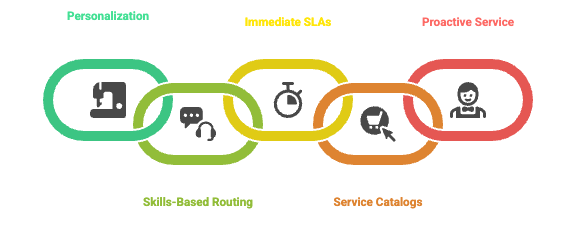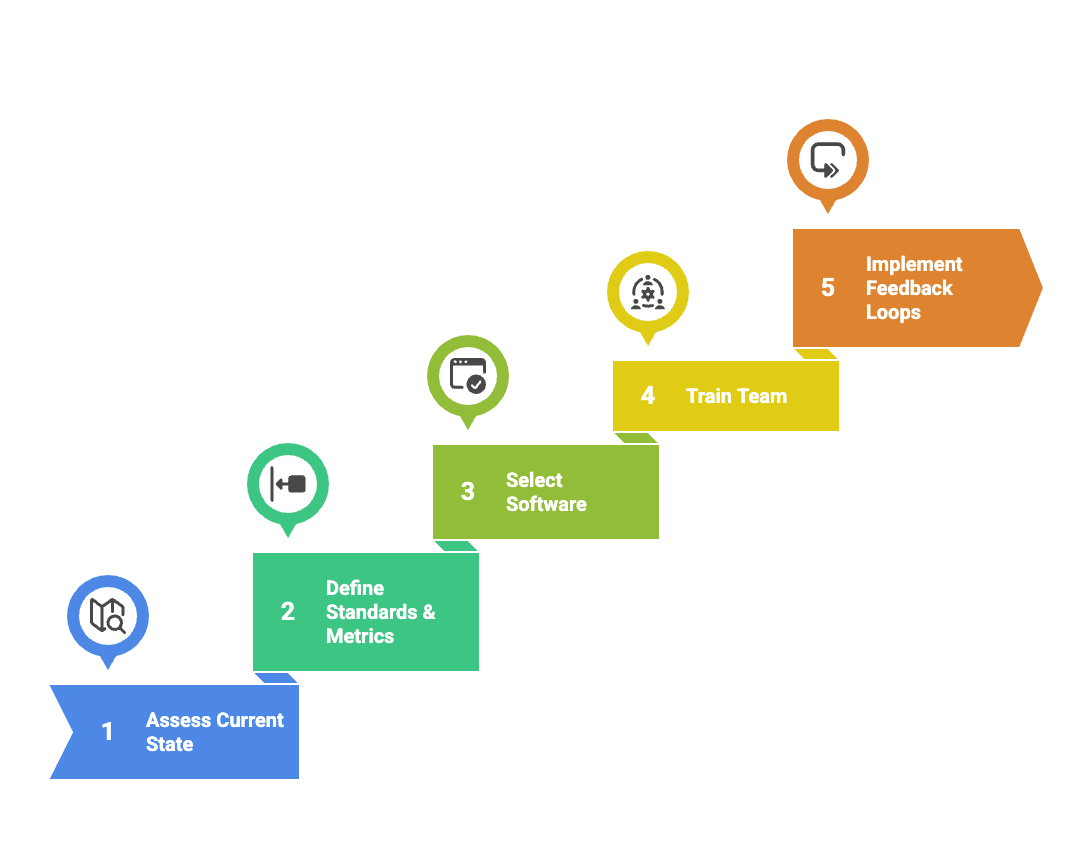Customer service management: A practical guide for business growth
Sneha Arunachalam
Aug 21, 2025

Customer service is the compass that helps customers navigate their journey with your brand. It’s not just about pointing north. It’s about adjusting course when things shift, guiding through tough terrain, and always staying oriented toward loyalty.
Customer service management makes sure that the compass is accurate, responsive, and never loses its sense of direction.
Customer service management goes beyond handling support tickets or addressing complaints. The systematic process orchestrates tasks between customers, service teams, and other departments to solve problems quickly and build lasting relationships.
This piece will help you turn your customer service operations into a growth engine that propels loyalty, retention, and business success.
Following are the topics covered in this article:
- Customer service management definition
- Why your business desperately needs a CSM strategy
- The real benefits you can measure
- Building your customer service management process step-by-step
- Practical strategies to implement right away
What is customer service management: Core concepts and definition
Picture this: A customer complaint pops into your support channel. Within minutes, your system identifies the issue, routes it to the best specialist, and kicks off a solution process involving multiple departments. Smooth, right? That's customer service management (CSM) in action—way beyond just answering customer queries.
Customer service management is the magical conductor orchestrating activities between customers, service teams, middle-office staff, operations, and other departments to solve customer issues quickly.
Customer Service Management (CSM) strategically drives activities between customers, service teams, middle-office staff, operations, back-office departments, and IT groups to resolve both common and complex customer issues efficiently.
The system goes beyond handling complaints to coordinate all customer interactions through principles, processes, and tools that drive satisfaction and loyalty.
The rise of customer service in modern business
Customer service has transformed remarkably through time. Businesses started to prioritize quality and customer satisfaction during the Industrial Revolution. Phone support and mail-order catalogs emerged in the early 20th century. The 21st century altered the map of customer service with:
- Digital technology that enabled data storage and faster order processing
- Internet that created global customer access through websites
- Smartphones that made customer service pocket-sized
- AI-powered chatbots that provided instant responses
A positive service experience makes 90% of customers more likely to make another purchase. This shows customer service's transformation from a cost center to a growth driver.
Key components of an effective customer service management system

A working CSM system combines several vital elements:
- Personalization: Customer profiles help tailor interactions based on priorities and history.
- Skills-based routing: Service requests automatically go to the most suitable agent based on expertise and availability.
- Immediate SLAs: Service Level Agreements need monitoring to manage issues before they escalate.
- Service catalogs: Predefined options start fully automated processes with minimal human touchpoints.
- Proactive service: Customer-needs get anticipated before they arise instead of just reacting to problems.
How CSM is different from traditional customer support
Customer service management (CSM) takes a proactive, strategic approach unlike traditional customer support's reactive operation. Support teams focus on resolving immediate product issues while CSM works with all departments to deliver a continuous connection.
CSM extends beyond traditional Customer Relationship Management (CRM). CRM targets sales and marketing optimization primarily, but CSM provides end-to-end solutions for customer problems.
The difference becomes clear in metrics: support teams measure resolution times and satisfaction scores, while CSM tracks customer retention, lifetime value, and business effects.
Customer Service Management | Traditional Customer Support |
Covers a broader scope encompassing the entire customer experience | Narrowed down focus on resolving specific issues |
Proactive and strategic approach | Reactive and tactical approach |
The timeline extends throughout the customer lifecycle | Often short-term, transaction-based interactions. |
Requires broader knowledge of company products, services, and policies | Requires specialized technical knowledge for troubleshooting |
Focus is on building long-term relationships and customer loyalty | Focus is on solving immediate problems and addressing concerns |
Drives customer retention, upsells, and brand advocacy | Primarily focused on issue resolution |
CSM fundamentally moves from treating service as a necessary cost to viewing it as a strategic growth driver that builds customer relationships over time.
Why your business needs a customer service management strategy
Let me paint you a picture: Two similar companies differ in just one way—how they handle customer service management. After six months, one runs on success while the other barely survives. What made such a difference? The answer lies in their customer service strategy's value and implementation.
The direct link between customer service and revenue growth
Numbers paint a clear picture. Companies that see customer service as a value center grow 3.5x more revenue than those who treat it as a cost center. These high-growth companies invest just 50 basis points more of their revenue in customer service to achieve these results.
Companies that put customers first can earn up to 80% more revenue than their less customer-focused rivals. Forrester's research shows that solving customer problems on first contact can add millions—even billions—to revenue. A good example shows airlines could add an estimated $705 million, while car manufacturers might see nearly $5 billion more in revenue.
How poor service management affects your bottom line
Think of customer service as the first domino. When it falls, everything else follows. One bad interaction triggers immediate revenue loss as customers bolt. This forces you to spend more on marketing, chasing new clients to replace the lost ones.
Your employees, facing a barrage of complaints, become demotivated, leading to costly turnover. And the final domino? Your brand's reputation, once pristine, is tarnished, impacting your long-term success. Essentially, a single point of failure cascades into widespread damage. So, definitely don't let your customer service be the first to fall.
Ground success stories: Businesses revolutionized by effective CSM
A telecommunications company adopted an all-encompassing customer service management approach. The results spoke volumes—their stock price doubled, revenues grew by 20%, and their NPS scores rose by 7-12 points.
A hardware company's shift to an IoT service provider changed its customer service strategy. This led to several new multi-million dollar global orders and faster solutions to problems.
These stories show why smart leaders now see customer service as more than just support—it's a vital engine that propels sustainable revenue growth.
The measurable benefits of customer service management
A wealth of satisfied customers stands behind every successful business, thanks to customer service management (CSM). Many companies see customer service as a cost center, but smart organizations know it's a measurable asset that helps grow their business.
Increased customer retention and lifetime value
The numbers tell a compelling story: profits can jump 25% to 95% with just a 5% boost in customer retention (Bain & Company). This is a big deal as it means that keeping existing customers becomes more valuable over time.
Customers stay loyal and make repeat purchases when they receive exceptional service. These loyal customers' Customer Lifetime Value (CLV) grows because they buy more often and spend more each time.
Research shows that happy customers have a higher lifetime value. They tend to buy premium products and extra services. Companies that focus on improving CLV through excellent service create better growth opportunities.
Enhanced brand reputation and word-of-mouth marketing
Word-of-mouth marketing shapes 20% to 50% of all buying decisions. Outstanding support turns customers into powerful brand champions.
Referrals bring in customers who are already primed to trust your brand. Unlike those drawn in by ads, they arrive with confidence, stay longer, and often invest more. It’s the kind of organic growth that not only builds loyalty but drives real business impact.
Customer service teams help create brand ambassadors by solving problems and building trust. These ambassadors increase CLV through their recommendations.
Operational efficiency and cost reduction
CSM does more than make customers happy—it optimizes operations. Companies can cut service team tasks by up to 80% with chatbot services and digital portals. This not only accelerates response and resolution times but also reduces overhead costs associated with manual processes and additional staffing.
Competitive advantage in crowded markets
CSM sets companies apart in today's digital world. About 80% of global consumers say a company's treatment affects their brand loyalty. Companies with mature customer experience strategies are six times more likely to hit their customer retention targets compared to those that haven't made CX a priority.
This edge improves profitability significantly. Operating profit grows nearly 6% for every 1% improvement in customer satisfaction.
Building your customer service management process
A customer service management process serves as a strategic blueprint. It outlines the steps and strategies needed to achieve customer satisfaction and loyalty.
Having these strategies in place helps to iterate the process faster for better customer service. Now, let’s have a look at how to build a customer service management process for your business.

Step 1: Assess your current customer service world
Start by getting a detailed view of your existing processes. Your assessment should review past customer interactions, analyze support data, and get input from both staff and customers.
Mystery shopping can give you a firsthand look at service quality. Pay attention to areas where customers feel frustrated—long wait times, mixed responses, or gaps in knowledge.
Step 2: Define clear service standards and metrics
After finding the gaps, set precise service standards that line up with your business goals. These standards should be SMART (specific, measurable, achievable, relevant, time-bound). Track these key metrics:
- First contact resolution rate
- Customer satisfaction scores (CSAT)
- Net Promoter Score (NPS)
- Average handle time
- Service level agreements
The right metrics help you spot warning signs in your service organization and keep standards high using past data.
Step 3: Select the right customer service management software
Modern customer service relies on technology that optimizes work and strengthens agents. Your team size and communication channels matter when picking software. Look for these features:
- Multi-channel support capabilities
- Ticketing systems for organization
- Automation for repetitive tasks
- Detailed analytics
- Customization options
Step 4: Train your team in essential customer service management skills
Training investment is vital—studies link employee satisfaction directly to learning opportunities. Focus your training on:
- Product knowledge and technical skills
- Communication and emotional intelligence
- Problem-solving abilities
- Knowledge-centered service methods
- Effective use of technology tools
A well-trained staff shows 37% higher productivity and 94% better employee retention.
Step 5: Implement feedback loops to improve constantly
Excellence requires a clear system to gather, analyze, and act on feedback. Your customer feedback loop should collect input and respond to it quickly. The best loop takes feedback, creates improvements, and gets more positive feedback. Successful organizations watch satisfaction levels closely, listen to feedback, and stay flexible in service delivery.
Conclusion
Customer service management makes the difference between business success and stagnation. A proper CSM implementation changes a basic support function into a powerful growth engine that boosts revenue, loyalty, and operational excellence.
Exceptional customer service needs a systematic approach. A well-trained team backed by the right technology and guided by clear metrics creates memorable experiences that keep customers coming back. Your business will see better retention rates, an improved brand reputation, and cost savings through streamlined processes.
Your dedication to continuous improvement determines CSM success. You need to listen to customer feedback, adapt processes, and focus on delivering value in every interaction. Companies that put customers first consistently outperform their competitors and achieve higher profits with eco-friendly growth.
Build your customer service management strategy today. You can start fresh or improve existing processes - each enhancement in customer service brings you closer to business excellence. Your customers want more than just support. They seek experiences that make them feel valued and understood.
Quick Summary: Customer Service Management – A Practical Guide
Customer Service Management (CSM) goes beyond ticket resolution to strategically align people, processes, and technology for seamless customer experiences and business growth.
Why It Matters
- Companies treating service as a growth driver see 3.5x revenue growth.
- Strong CSM boosts retention, loyalty, and reputation, while poor service leads to churn and higher costs.
Benefits
- Higher customer lifetime value & retention
- Stronger brand reputation & referrals
- Greater efficiency through automation
- Clear competitive advantage
How to Build It
- Assess current service processes
- Set SMART service metrics (CSAT, NPS, FCR)
- Choose the right CSM software
- Train and empower teams
- Create feedback loops for continuous improvement
Takeaway
CSM transforms service from a cost center into a growth engine, driving revenue, efficiency, and lasting customer loyalty.
Frequently Asked Questions
An effective customer service management system includes personalization, skills-based routing, SLAs, service catalogs, and proactive service. These components work together to create a seamless customer experience and drive business growth.
Customer service management directly impacts revenue growth. Companies that view customer service as a value center achieve 3.5 times more revenue growth compared to those treating it as a cost center.
Implementing a customer service management strategy leads to increased customer retention and lifetime value, enhanced brand reputation, operational efficiency, and a competitive advantage in crowded markets. Even a 5% increase in customer retention can boost profits by more than 25% (Bain & Company).
To build a customer service management process, businesses should follow these steps: assess the current customer service landscape, define clear service standards and metrics, select the right customer service management software, train the team in essential skills, and implement feedback loops for continuous improvement.
Technology plays a crucial role in modern customer service management. The right software can streamline workflows, empower agents, and provide features like multi-channel support, ticketing systems, automation for repetitive tasks, comprehensive analytics, and customization options.
